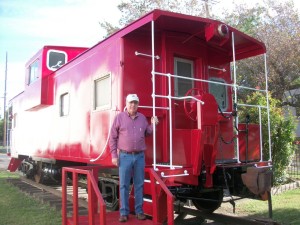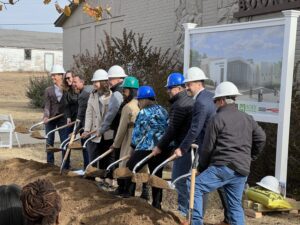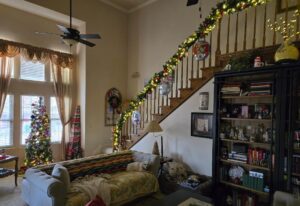 Trains, except those running as tourist excursions for history buffs, no longer use cabooses. But Sapulpa’s caboose is serving in a multi-functional way at the Jim Hubbard Plaza at TSU Park on Historic Route 66.
Trains, except those running as tourist excursions for history buffs, no longer use cabooses. But Sapulpa’s caboose is serving in a multi-functional way at the Jim Hubbard Plaza at TSU Park on Historic Route 66.
The caboose recently received a new coat of paint and is really looking good right down to the white trim. The caboose is bright red.
TSU purchased the caboose from the Burlington Northern back in 1988 when the railroad began selling them off at bargain prices.
“TSU never used a caboose in our own operations,” said Russel Crosby who runs operations at TSU, “but they were going cheap, and it could be delivered by rail to us here at Sapulpa.” (All for about $2,500. If cabooses were being built today, it is not unreasonable to estimate a $100,000-150,000 price tag).
Crosby said cabooses had already become a novelty in the late 1980s.
“We wanted it just for the sake of having one since they were passing from the railroad scene.”
Today the caboose and several other historic rail pieces including Sapulpa’s last remaining electric trolley car can be viewed by the public and Route 66 tourists at the TSU park, 701 E. Dewey.
“You do not see a lot of them in service anymore on the railroads,” Crosby said. “They have been replaced
by a computer at the rear end of train. Also some of the crew members have been displaced from the old days
when cabooses were in use.” (See earlier story: “Hey, where’s the caboose?”)
TSU did run the caboose a couple of times to provide ride on TSU rails for some people.
“But for the most part it just sat here at TSU,” Crosby said. “When the trolley came on the scene we had Bennett Steel move the caboose over to the other side of the building on some track we had prepared.”
Used in conjunction with the trolley display and the opening of the Jim Hubbard Plaza (thusly named to honor the late historian and prime mover to restore the trolley) the caboose also served as a souvenir shop and to house other trolley memorabilia.
One of the main things that can be seen inside the caboose is a neat and well-crafted layout of the Harvey House in N-scale built by Pete Egan.
It is believed the caboose at Sapulpa dates from the 1960s to 1970s as far as when it may have been constructed and in use.
“It is not old, as cabooses go,” Crosby said. “The old wood ones are the most in demand.”
Cabooses were used to provide shelter for crew at the end of a train who did the switching and shunting, kept a lookout for load shifting, damage to equipment and cargo, and overheating axles.
In other tidbits we found in some of our train sources:
Originally cabooses were flatcars fitted with cabins or sometimes, modified box cars. The projections above or to the sides of the car were added to allow crew better observation. The caboose also served as the conductor’s office (he’s the guy in charge of the train), and on long routes included accommodation and cooking facilities. Coal or wood was originally used to fire a cast iron stove for heat and cooking, later giving way to a kerosene heater. Now rare, the old stoves can be identified by several essential features. They were without legs, bolted directly to the floor, and featured a lip on the top surface to keep pans and coffee pots from sliding off. They also had a double-latching door, to prevent accidental discharge of hot coals caused by the rocking motion of the caboose.
Cabooses were used on every freight train until the 1980s, when safety laws requiring the presence of cabooses and full crews were relaxed. Developments in monitoring and safety technology such as lineside defect detectors and End of Train Device resulted in crew reductions and the phasing out of caboose cars. Nowadays, says internet sources, they are generally only used on rail maintenance or hazardous materials trains, or on heritage and tourist railroads.
The most common caboose form in American railroad practice has a small windowed projection on the roof, called the cupola. The crew sat in elevated seats to inspect the train from the perch.
The classic idea of the “little red caboose” at the end of every train came about when cabooses were painted red. The most notable was the Santa Fe which in the 1960s started a rebuild program for their cabooses in which the cars were painted bright red with an eight-foot-diameter Santa Fe cross herald emblazoned on each side in yellow.
Railroad historian David L. Joslyn (a retired Southern Pacific Railroad draftsman) has traced the possible root of “caboose” to the obsolete Low German word Kabhuse, a small cabin erected on a sailing ship’s main deck. This was absorbed into Middle Dutch and entered the Dutch language circa 1747 as kabhuis, the compartment on a ship’s main deck in which meals were prepared.
The earliest known printed record of “caboose” used to describe the railcar appeared in 1859 in court records in conjunction with a lawsuit filed against the New York and Harlem Railway.
TSU traces its origin back to when Oklahoma became a state in 1907. That was the year Sapulpa and Interurban Railway was incorporated. The line operated as an interurban streetcar line using trolley cars around Sapulpa, Oklahoma. It also extended rail lines towards the communities of Glenpool and Kiefer, Oklahoma. This was at an exciting time in Oklahoma history when the oil industry was coming of age. The line provided transportation for the oil field workers and business people in these growing oilfields and communities.
Russell Crosby of TSU shown with Sapulpa’s bright red caboose in the TSU yard as part of the Jim Hubbard Plaza on Route 66. The caboose along with Sapulpa Trolley and Rail Museum’s old electric trolley attracts hundreds of visitors.










